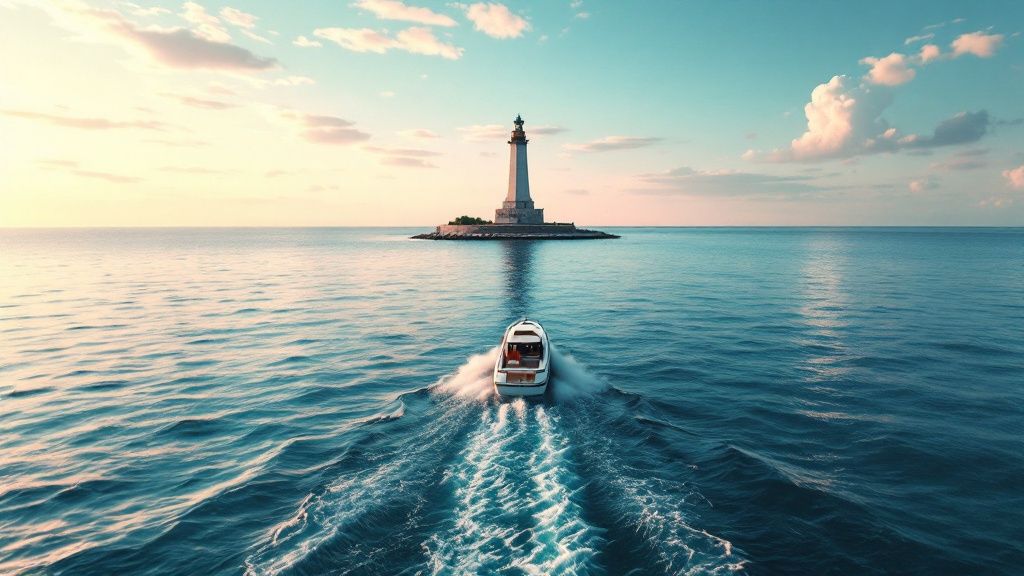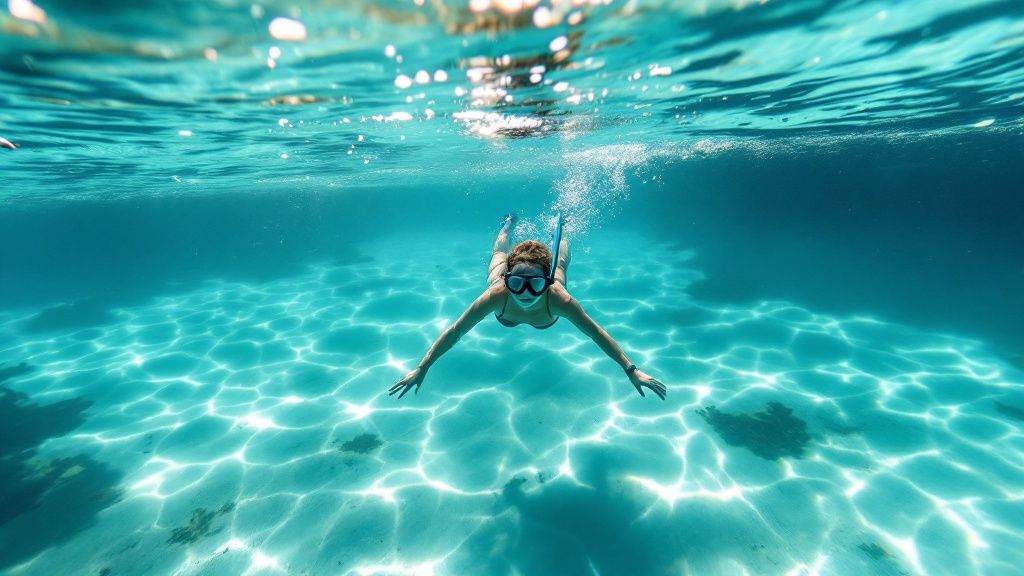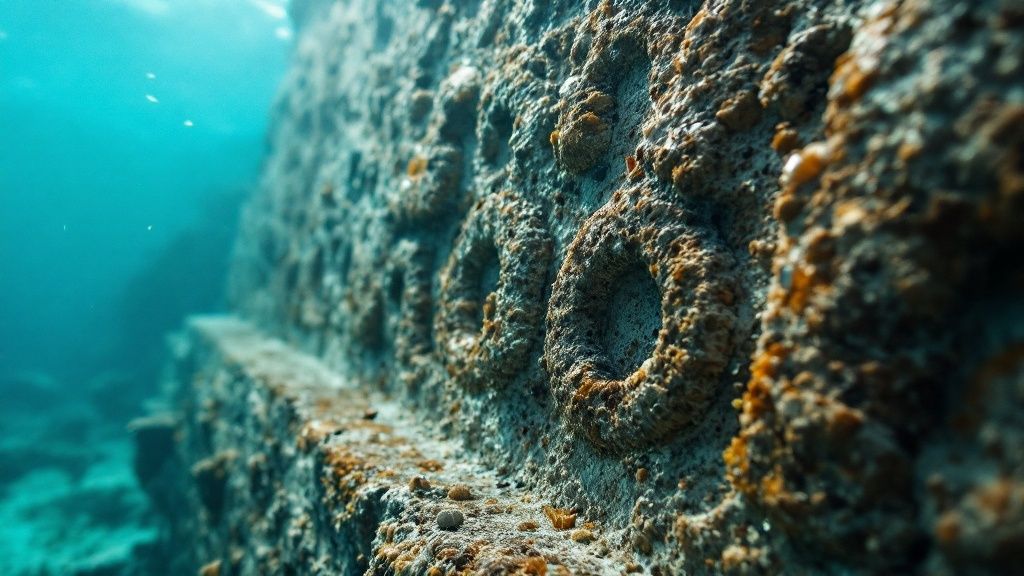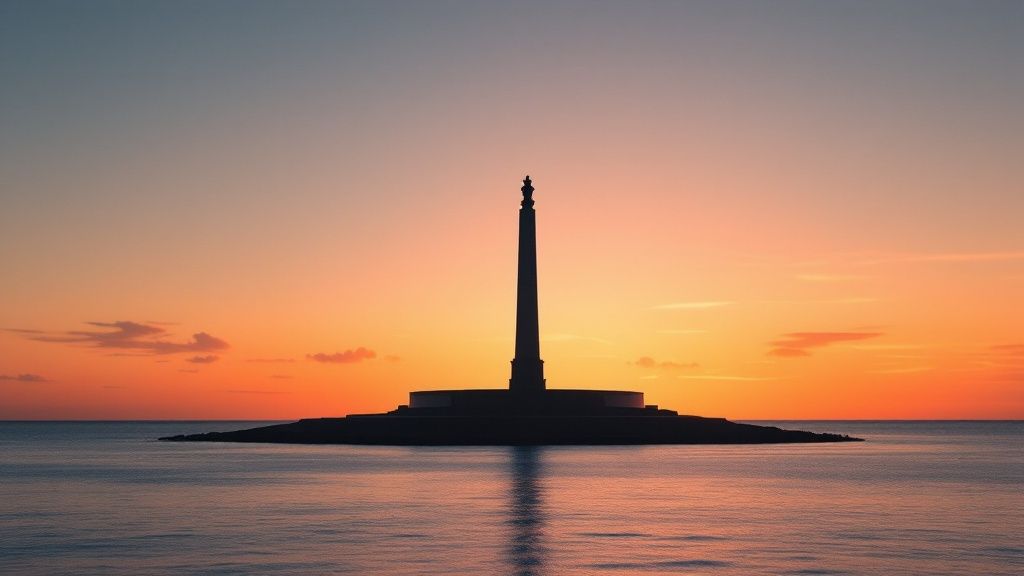Dive into Snorkeling Captain Cook Monument
- Kona Snorkel Trips
- Apr 17
- 15 min read
The Magic of Snorkeling Captain Cook Monument

Snorkeling at Captain Cook Monument isn't just a dip in the ocean; it's an immersion into a world where history and nature converge. Unlike other Hawaiian snorkeling spots, this location offers a unique blend of cultural significance and a rich, thriving ecosystem. Located in a remote corner of Kealakekua Bay, it consistently ranks as a top snorkeling destination in Hawaii.
What makes it so special? The thriving ecosystem surrounding the monument is a key factor. This pristine environment offers a chance to observe Hawaiian marine life in its undisturbed natural habitat.
The vibrant coral reefs teem with activity and a dazzling display of colorful fish.
Why Kealakekua Bay Is Special
Kealakekua Bay itself is a remarkable destination, weaving together natural beauty and historical importance. The 27-foot obelisk monument marks the spot where Captain James Cook was killed in 1779. This event significantly impacted Hawaiian history, leading to increased interaction with the Western world.
Today, Kealakekua Bay attracts over 190,000 visitors annually, drawn to both the historical monument and the bay’s abundant marine life. As a Marine Life Conservation District, the bay protects a unique ecosystem. Approximately 70% of Hawaii's marine species are endemic to the area, meaning they are found nowhere else on Earth.
Snorkelers can witness vibrant coral reefs, schools of bright yellow tang, raccoon butterflyfish, and a multitude of other thriving species in these protected waters. This combination of rich cultural heritage and vibrant underwater life creates a special snorkeling experience that emphasizes both preservation and education. Learn more at Captain Cook Monument snorkeling.
Planning Your Snorkeling Adventure
Whether you choose the ease of a guided boat tour or the freedom of kayaking, planning is essential for a rewarding snorkeling experience. Several reputable tour operators offer excursions to the monument, including Captain Cook Snorkeling Tours, Kona Honu Divers and Kona Snorkel Trips. Guided tours often provide equipment, insightful commentary, and a safe, structured experience.
For the more adventurous, kayaking to the monument offers a more independent and personalized experience. However, this requires obtaining permits and paying close attention to weather conditions. For more resources, check out our guide on sitemaps. You might also be interested in Manta Ray Night Snorkels. Kayaking allows you to explore the bay at your own pace, discovering hidden coves along the way. Regardless of your chosen method, the journey to this protected location rewards you with an exceptional snorkeling experience unique to Hawaii.
Crystal Clear Waters: The Underwater Visibility Advantage

Snorkeling at Captain Cook Monument offers more than just a glimpse into history. It's an immersion into an underwater world renowned for its exceptional clarity. This remarkable visibility transforms a typical snorkel trip into a truly unforgettable adventure. But what makes this location so special?
Kealakekua Bay, home to the monument, boasts visibility that regularly reaches an astounding 100 feet. This is exceptional, even by Hawaiian standards. This clarity is a result of several factors. Natural filtration from underwater freshwater springs plays a key role. Ocean currents also circulate, preventing sediment buildup. Finally, the bay's protected topography shields it from disruptive waves and storms.
The Factors Behind the Clarity
The crystal-clear views at Captain Cook Monument are due to a unique combination of natural processes. Freshwater springs, flowing beneath the surface, act as a continuous natural filtration system. These springs constantly refresh and purify the bay's water.
The bay’s natural geography also plays a significant role. The surrounding cliffs and the unique shape of the bay minimize the impact of waves and storms. This prevents sediment from being stirred up, keeping the water calm and clear, perfect for snorkeling. For a different kind of underwater adventure, check out the Manta Ray Night Snorkel.
A Haven for Underwater Photography
The exceptional visibility at Captain Cook Monument makes it a dream destination for underwater photographers. Imagine capturing vibrant images of coral reefs and diverse fish populations with breathtaking clarity. The pristine conditions allow photographers to document the bay’s vibrant biodiversity in stunning detail.
Depth and Diversity: An Experience for All
Kealakekua Bay offers varying depths, catering to snorkelers of all skill levels. Shallow areas, averaging around 25 feet, are ideal for beginners and families. These shallows provide comfortable and safe environments for observing marine life up close. More experienced snorkelers can explore deeper areas, reaching depths of 153 feet, to discover new species and underwater landscapes.
Witnessing the Wonder
Visitors often describe the water clarity at Captain Cook Monument as otherworldly. The vibrant colors of the coral and fish appear incredibly vivid. This clarity adds another dimension to the snorkeling experience, making it feel like exploring a massive, crystal-clear aquarium. The average snorkeling depth is around 25 feet, but some areas plunge to depths of 153 feet, providing a range of habitats for diverse marine life.
This area is a designated Marine Life Conservation District, contributing to the health and abundance of the coral and fish. Thousands of snorkelers visit annually to witness this vibrant underwater ecosystem. Learn more about snorkeling tours and book your adventure with Captain Cook Snorkeling Tours or explore other providers such as Kona Snorkel Trips. The unparalleled visibility is what truly distinguishes snorkeling at Captain Cook Monument, making it an immersive experience into one of Hawaii's most spectacular underwater realms. You can also explore more about snorkeling Captain Cook monument.
Extraordinary Marine Life Encounters at Captain Cook

Captain Cook Monument isn't just a historical landmark; it's a portal to a thriving underwater world. This protected bay in Hawaii offers an incredible opportunity to explore a vibrant marine ecosystem, teeming with fish species rarely seen anywhere else. Snorkeling at Captain Cook is a chance to connect with a truly unique part of the ocean.
This area is considered a living treasure by marine biologists. When you snorkel here, you're not just observing; you're getting a glimpse into a delicate and fascinating ecosystem.
Identifying The Reef’s Inhabitants
Learning to identify the various endemic butterflyfish is a rewarding part of the experience. Their intricate patterns and unique behaviors offer a window into the complexity of reef life. You’ll also be mesmerized by the schools of yellow tang, their bright bodies flashing against the coral backdrop.
The following table highlights some of the commonly seen marine life in the area. It provides a quick guide to their appearance, where you might find them, and some interesting facts about each species.
To make your snorkeling experience even more enriching, consider going with an expert guide. They can help you locate some of the more elusive reef inhabitants and teach you how to observe them respectfully without disturbing their natural habitat.
Species | Appearance | Where to Spot | Interesting Facts |
|---|---|---|---|
Yellow Tang | Bright yellow, oval-shaped body | Shallow reefs, often in schools | Graze on algae, helping to keep the reef healthy |
Butterflyfish (various species) | Thin, disc-shaped bodies with diverse patterns | Around coral heads | Many species are endemic to Hawaii |
Reef Triggerfish (Humuhumunukunukuapua'a) | Triangular body, often brightly colored | Near the reef floor | Hawaii's state fish, known for their "trigger" fin |
Moray Eel | Long, snake-like body | Crevices and holes in the reef | Nocturnal hunters with sharp teeth |
Soft-bodied, eight arms, can change color | Hiding in rocks and crevices | Masters of camouflage and highly intelligent |
This table serves as a starting point for identifying the diverse marine life you might encounter while snorkeling at Captain Cook Monument. Remember to observe these creatures respectfully and enjoy the vibrant underwater world they inhabit.
Guides can share insights into the unique habits of the creatures you encounter. You might even be lucky enough to spot seasonal visitors like manta rays, making your snorkeling adventure truly unforgettable. For more information and resources, explore our blog post sitemap, which covers various topics related to Captain Cook.
Capturing The Moment Responsibly
The clear waters and incredible biodiversity of Captain Cook Monument attract professional underwater photographers from around the world. They've perfected the art of capturing stunning images without harming the delicate coral or disturbing the marine life.
This mindful approach to photography is essential for preserving this pristine environment. It ensures that future generations can continue to enjoy the beauty and wonder of this special place. Unfortunately, not all Hawaiian reefs are as healthy. Many face serious threats, including pollution and climate change.
Learning about the challenges facing these reefs highlights the importance of protected areas like Kealakekua Bay. Conservation experts can explain why the marine life at Captain Cook Monument thrives while other reefs struggle.
A Thriving Ecosystem
The remarkable biodiversity at Captain Cook Monument is a testament to the success of ongoing conservation efforts. The bay’s protected status allows marine life to flourish in a relatively undisturbed environment, offering a glimpse into what a healthy reef can be.
This thriving ecosystem provides valuable insights for other conservation projects throughout Hawaii. By understanding the factors contributing to Kealakekua Bay’s health, scientists and conservationists can develop effective strategies to protect other threatened reef systems. For guided tour options, check out Captain Cook Snorkeling Tours, Kona Honu Divers, and Kona Snorkel Trips. Learn more about the unique Manta Ray Night Snorkels.
Whether you’re a seasoned snorkeler or a first-timer, Captain Cook Monument offers a memorable and educational experience. The combination of clear waters and abundant marine life makes this a truly unique snorkeling destination. This vibrant underwater ecosystem is waiting to be explored.
Conservation in Action: Protecting Paradise

Kealakekua Bay, a place where vibrant coral gardens meet historical significance, represents a delicate balance. This balance exists between the bay's natural wonders and the impact of human interaction. Preserving this special place, including the snorkeling Captain Cook monument, for generations to come requires ongoing, active conservation efforts. Thankfully, significant measures are already in place to protect this unique environment.
The Marine Life Conservation District: A Sanctuary for Marine Life
The designation of Kealakekua Bay as a Marine Life Conservation District has played a vital role in protecting its diverse ecosystem. This special status provides legal protection for the bay's marine life, encompassing everything from fish and coral to various other aquatic organisms.
This designation restricts certain activities, such as fishing and collecting marine life. By limiting these activities, the fish and coral populations are allowed to thrive. This protection has transformed the bay into a vibrant underwater sanctuary.
The flourishing coral reefs provide shelter and food for a wide array of fish species, contributing to the area's rich biodiversity. The abundant populations of yellow tang and butterflyfish, for instance, are a direct result of these protective measures.
Managing Tourism's Impact
Tourism brings valuable economic benefits, but it also presents challenges to Kealakekua Bay's sensitive ecosystem. The continuous flow of visitors necessitates careful management to mitigate any negative impacts. Effective strategies are employed to strike a balance between supporting tourism and preserving the bay.
Maintaining this balance is crucial. Kealakekua Bay’s thriving ecosystem draws snorkelers from all over the world, especially those wanting to experience the Captain Cook monument. By carefully managing tourism, we can ensure future generations will have the same opportunity. Learn more about planning your visit in our article about store products.
Practical Conservation Measures
Managing Kealakekua Bay requires addressing both conservation and tourism-related pressures. This is due to its popularity combined with its sensitive cultural and natural resources. Surveys demonstrate strong local support for regulations. For example, over 77% of residents support requiring tour boat operators to have government permits. Another 65% support commercial kayaks displaying government decals.
To address environmental and safety concerns, policies limit the number of boats and kayaks allowed in the bay at the same time. Only four snorkel boats, carrying a maximum of 72 passengers, are allowed at any given time. Additionally, the limit is set at 36 kayaks with a total of 52 kayakers.
Approximately 200 visitors arrive daily through commercial tours, with an additional 30 to 50 arriving independently by kayak. These measures help address issues such as inappropriate anchoring, illegal fishing, harassment of dolphins, and unauthorized commercial activity. The 2009 Kealakekua Stewardship Area Management Plan recommends over 146 actions to preserve the bay’s historical, cultural, and environmental integrity. This careful management helps ensure that snorkeling at the Captain Cook Monument remains sustainable. It also safeguards the area's rich marine life and historical significance for generations to come. More detailed statistics are available here.
Being a Responsible Visitor
Visitors play a critical role in preserving Kealakekua Bay. Simple choices, like using reef-safe sunscreen, can make a significant difference. Reef-safe sunscreens don't contain chemicals that harm coral and marine life.
Maintaining a safe viewing distance from marine life is another essential practice. This ensures we don't disturb their natural behaviors or habitats. By following these simple guidelines, everyone can contribute to protecting this unique environment. Consider booking a tour with Captain Cook Snorkeling Tours, Kona Honu Divers, or Kona Snorkel Trips. For an unforgettable evening experience, check out Manta Ray Night Snorkels.
Reaching Paradise: Tour Options and Access Strategies
Planning a snorkeling trip to the Captain Cook Monument? It's a snorkeling paradise, but getting there requires some thought. Different approaches suit different budgets, experience levels, and how much adventure you're seeking. Let's explore the three main ways to reach this incredible spot: boat tours, kayaking, and hiking.
Boat Tours: Comfort and Convenience
Boat tours are the easiest and most accessible way to reach the monument. They're perfect for families, beginner snorkelers, or anyone who prefers a relaxed, guided experience.
Variety of Options: Numerous tour operators offer snorkeling trips, with different boat sizes, amenities, and trip lengths. Think about your group size, preferred boat type (catamaran, zodiac, etc.), and what's included (snacks, drinks, equipment). Companies like Captain Cook Snorkeling Tours specialize in this area and offer a unique experience.
Expert Guidance: Boat tours usually include certified guides who provide safety information, snorkeling tips, and insights into the local marine life and history. This is especially helpful for beginners and adds another layer of enjoyment for experienced snorkelers.
Time Efficiency: Boats get you to the monument quickly, maximizing your snorkeling time. This is great if you're short on time or want to do other things during your day.
Kayaking: An Adventurous Pursuit
If you prefer a more active, independent adventure, kayaking to the monument is a rewarding option. But it's important to understand the physical demands and safety aspects.
Permit Requirements: You'll need a permit to kayak to Captain Cook Monument. Contact local authorities or rental providers for details on how to get one.
Rental Options: Several places rent kayaks and safety equipment. Choose a reputable provider with a focus on safety and well-maintained gear.
Physical Demands: The kayak trip is about 2.5 miles each way and can be tough, especially in windy conditions. Be realistic about your fitness level and kayaking experience.
Safety First: Kealakekua Bay's weather can change rapidly. Check the forecast before going and be prepared to turn back if conditions worsen. Always wear a life jacket and tell someone your plans.
Unique Perspective: Kayaking offers a unique view of the coastline and lets you explore the bay at your own rhythm. It's ideal for those who love physical activity and a more personalized experience.
Hiking: A Challenging Trek
Hiking to the monument is the least common and most challenging option. It's a steep, 4-mile roundtrip hike down (and then back up) a rugged cliffside trail.
Physical Fitness: This option demands a high fitness level and isn't recommended for those with mobility issues or a fear of heights. The trail can be difficult, particularly in the heat.
Preparation is Key: Pack plenty of water, sunscreen, and good hiking shoes. Start early to avoid the midday sun and give yourself ample time for the descent and ascent.
Limited Shade: There's little shade on the trail, so sun protection is crucial.
Rewarding Views: The hike offers breathtaking views of Kealakekua Bay, making the challenge worthwhile.
Choosing the Right Option
To help you decide, here's a table comparing the different ways to access the Captain Cook Monument for snorkeling:
Captain Cook Monument Access Options Compared: A comprehensive comparison of different ways to reach the Captain Cook Monument for snorkeling.
Access Method | Approximate Cost | Duration | Physical Difficulty | Pros | Cons |
|---|---|---|---|---|---|
Boat Tour | $80-$150 | 2-4 hours | Easy | Convenient, guided experience, equipment provided | Less independence, potential for crowds |
Kayaking | $40-$70 (rental) | 4-6 hours | Moderate to Strenuous | Independent exploration, closer to nature | Physically demanding, permit required, safety considerations |
Hiking | Free (parking fees may apply) | 4-6 hours | Strenuous | Spectacular views, sense of accomplishment | Physically demanding, limited accessibility, no shade |
As you can see, each method provides a distinct experience. Boat tours are quickest and easiest. Kayaking offers adventure and independence. Hiking provides a challenge and incredible views.
For more planning resources, check out our sitemap. Other excellent resources for snorkeling tours include Kona Honu Divers, Manta Ray Night Snorkel, and Kona Snorkel Trips. Remember to research, consider your abilities, and prepare well for a safe and unforgettable snorkeling adventure.
Perfect Timing and Preparation For An Unforgettable Dive
Want to elevate your snorkeling experience at Captain Cook Monument from good to extraordinary? It all comes down to two crucial factors: timing and preparation. Understanding the rhythms of Kealakekua Bay—its weather patterns, seasonal marine life, and typical visitor flow—will help you pinpoint the perfect moment for your visit. This preparation is the foundation of a truly unforgettable snorkeling adventure.
The Early Bird Catches The Calm
Why is early morning snorkeling at Captain Cook Monument so highly recommended? It's about more than just beating the crowds. The early hours offer remarkably calm waters, often resembling a glass surface, ideal for observing the vibrant marine life below. Plus, many species are most active in the cooler morning hours, increasing your chances of spotting a variety of fish, including the dazzling yellow tang. This early start maximizes your opportunities to witness unique underwater behaviors.
Seasonal Considerations For The Perfect Snorkel
The season you choose significantly impacts your snorkeling experience at Captain Cook Monument. Local guides and experienced visitors agree that certain months offer the best conditions: optimal water clarity, comfortable temperatures, and abundant marine life. While Kealakekua Bay is generally accessible all year, the summer months (May-September) often provide the calmest waters and warmest temperatures. However, this is also peak tourist season, so expect more people sharing the bay.
Spring and fall provide a pleasant balance, with fewer crowds and enjoyable conditions. During winter (December-April), you might experience larger swells and cooler water, making the right wetsuit a must-have. Understanding these seasonal variations helps you tailor your trip to your personal preferences and tolerance for crowds and varying weather.
Preparing For Your Underwater Adventure: A Packing Guide
Careful packing is key to a safe and enjoyable snorkeling experience. Consider these recommendations:
Essential Gear: A well-fitting mask, snorkel, and fins are essential for any snorkeler. Rentals are available, but bringing your own guarantees a perfect fit and addresses any hygiene concerns.
Sun Protection: The Hawaiian sun is intense. Pack reef-safe sunscreen with high SPF, a wide-brimmed hat, and UV-protective clothing or a rash guard for protection both in and out of the water. This safeguards your skin and protects the delicate coral reef.
Seasickness Prevention: If you're susceptible to seasickness, particularly on boat trips, take precautions. Consult your doctor about motion sickness remedies, or explore natural options like ginger candies or acupressure wristbands.
Hydration is Key: Staying hydrated is crucial in Hawaii's warm climate. Pack a reusable water bottle and refill it throughout the day. Hydration prevents fatigue and enhances your overall snorkeling experience.
Specialized Equipment: Photography enthusiasts will want underwater cameras or housings. Less experienced swimmers might consider a flotation device or life vest. Families with children should pack appropriate-sized gear and ensure everyone is comfortable in the water.
For more planning tips, check out this sitemap navigation. These recommendations help ensure a fantastic snorkeling experience at Captain Cook Monument. Consider booking a guided tour with experienced operators like Captain Cook Snorkeling Tours, Kona Honu Divers, or Kona Snorkel Trips. For a unique evening experience, check out Manta Ray Night Snorkels. By combining the right timing with thorough preparation, your snorkeling adventure at Captain Cook Monument will undoubtedly be a cherished memory.
Historic Waters: Snorkeling Where Worlds Collided
Snorkeling at Captain Cook Monument offers more than just an underwater glimpse of marine life; it’s a journey through a pivotal moment in Hawaiian history. The crystal-clear waters of Kealakekua Bay hold a profound significance, enriching the snorkeling experience with a palpable sense of the past. This bay witnessed a dramatic clash of cultures, forever altering Hawaii's relationship with the outside world.
Captain Cook's Final Voyage and Its Impact on Hawaii
In 1778, Captain James Cook's arrival marked the first documented European contact with the Hawaiian Islands. Initially greeted with curiosity and perhaps even awe, Cook's interactions with the local communities became increasingly complicated. His third and final voyage in 1779 met a tragic end in Kealakekua Bay, the very location now marked by the monument. This event irrevocably changed the trajectory of Hawaiian history, opening the door to increased Western influence and shaping the islands’ destiny.
From Conflict to Reflection: The Transformation of Kealakekua Bay
Kealakekua Bay has undergone a remarkable transformation. Once a scene of cross-cultural conflict, it now stands as a place of quiet reflection and breathtaking natural beauty. The Captain Cook Monument serves as a poignant reminder of this historic encounter. The surrounding bay, now a protected marine sanctuary, teems with vibrant coral reefs and a dazzling array of fish. This powerful juxtaposition of history and nature creates a truly unique and thought-provoking experience.
A British Footprint in Hawaiian Waters
Adding yet another layer of intrigue, the Captain Cook Monument holds a unique distinction: it's considered British territory within Hawaii. This unusual arrangement underscores the site's intricate historical significance, reflecting its connection to British history and its lasting link to Captain Cook's legacy.
Connecting Past and Present Through Snorkeling
Understanding the historical context dramatically enhances the snorkeling experience at Kealakekua Bay. As you explore these waters, you’re not merely observing marine life; you’re connecting with a significant chapter in Pacific history. It transforms the activity from simple sightseeing into a deeper appreciation for Hawaii’s rich and complex past.
Exploring Hawaiian Culture and History
Want to delve deeper into this fascinating history? Numerous resources offer further insights into Hawaiian culture and the events surrounding Captain Cook's arrival and its impact. Local museums, cultural centers, and historical societies provide invaluable context and information, enriching your understanding and appreciation of this historically significant area.
Looking for an unforgettable snorkeling adventure immersed in history and natural wonder? Book your tour today with Captain Cook Snorkeling Tours! We offer diverse excursions, from four-hour coastal adventures to unique manta ray night snorkeling trips. Our expert guides share their in-depth knowledge of the local marine ecosystem and the captivating history of Kealakekua Bay. Explore the wonders of Captain Cook Monument with us! We also recommend these excellent resources: Kona Honu Divers, Manta Ray Night Snorkel, and Kona Snorkel Trips.
